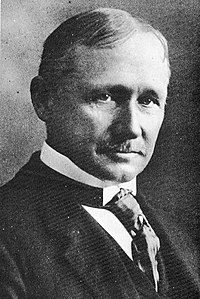 In our last installment, we heard Taylor state that cooperation between management and workers was the essence of scientific management. Now it's time to query him about what scientific management actually is. So here we go....
In our last installment, we heard Taylor state that cooperation between management and workers was the essence of scientific management. Now it's time to query him about what scientific management actually is. So here we go....The new role of management under scientific management is to provide task-level standardization of methods to achieve maximum efficiency from each worker. In return for vastly increased productivity, workers must receive 30-100% increase in wages or else they will simply not agree to work in a new way. With management taking on half the burden of the work, in the form of task-level planning, and the increase in pay, labor-management relations will be automatically close and cordial (cf. p. 27).
Taylor's thesis was that only through scientific management could both employer and worker fulfill their needs and ambitions and that once those criteria were met, there would no longer be any cause for labor unrest. The backdrop to Taylor's work was the intense, violent, and often bloody warfare then taking place between owners and workers, both in the US and in Europe. There was also the ideological struggle being waged between industrial capitalism, socialism/communism, and anarchism. Taylor attempted to demonstrate that by cooperating in a spirit of shared sacrifice, labor and management could work together for the benefit of everyone. We'll assess the success of his prescriptions in that area later as well. Suffice it to say that following a visit by Taylor to a workplace, 80%-90% of the original workforce joined the ranks of the unemployed. But back to our Taylor haunting....
Taylor urged management to take on the responsibility of collecting all of the tacit knowledge of every trade practiced in their enterprise and “classifying, tabulating, and reducing this knowledge to rules, laws, and formulae which are immensely helpful to the workmen in doing their daily work.” Management would also take on four essential tasks that form the heart of scientific management:
- Develop the science for each element of the work every worker performs, using time and motion studies, etc.
- Scientifically select, train, teach, and develop each worker to the highest level. Previously workers chose their own work and carried out their own training by whatever means they could arrange.
- Management must “heartily cooperate with the men so as to insure all of the work [is] being done in accordance with the principles of the science which has been developed.” This means training at the task level.
- Almost equal division of work and responsibility between management and labor, with management taking on the science and task-level direction of each worker (cf. pp. 36-37).
So where are we at? So far we have vastly improved productivity, a recommendation for much higher wages, labor-management cooperation, task-level direction, and extreme and increasing division of labor. That is at best a mixed ledger. Next time, we'll look at Taylor's ideas on cooperation and how it is to be achieved. We'll also begin to form a picture of what scientific management meant to the people doing the work. And don't worry -- we'll get to the Agile connection very soon.
All for now....
...-.-
References
Taylor, Frederick Winslow, The Principles of Scientific Management. New York & London: Harper, 1911, reprint edition, 1934.






No comments:
Post a Comment